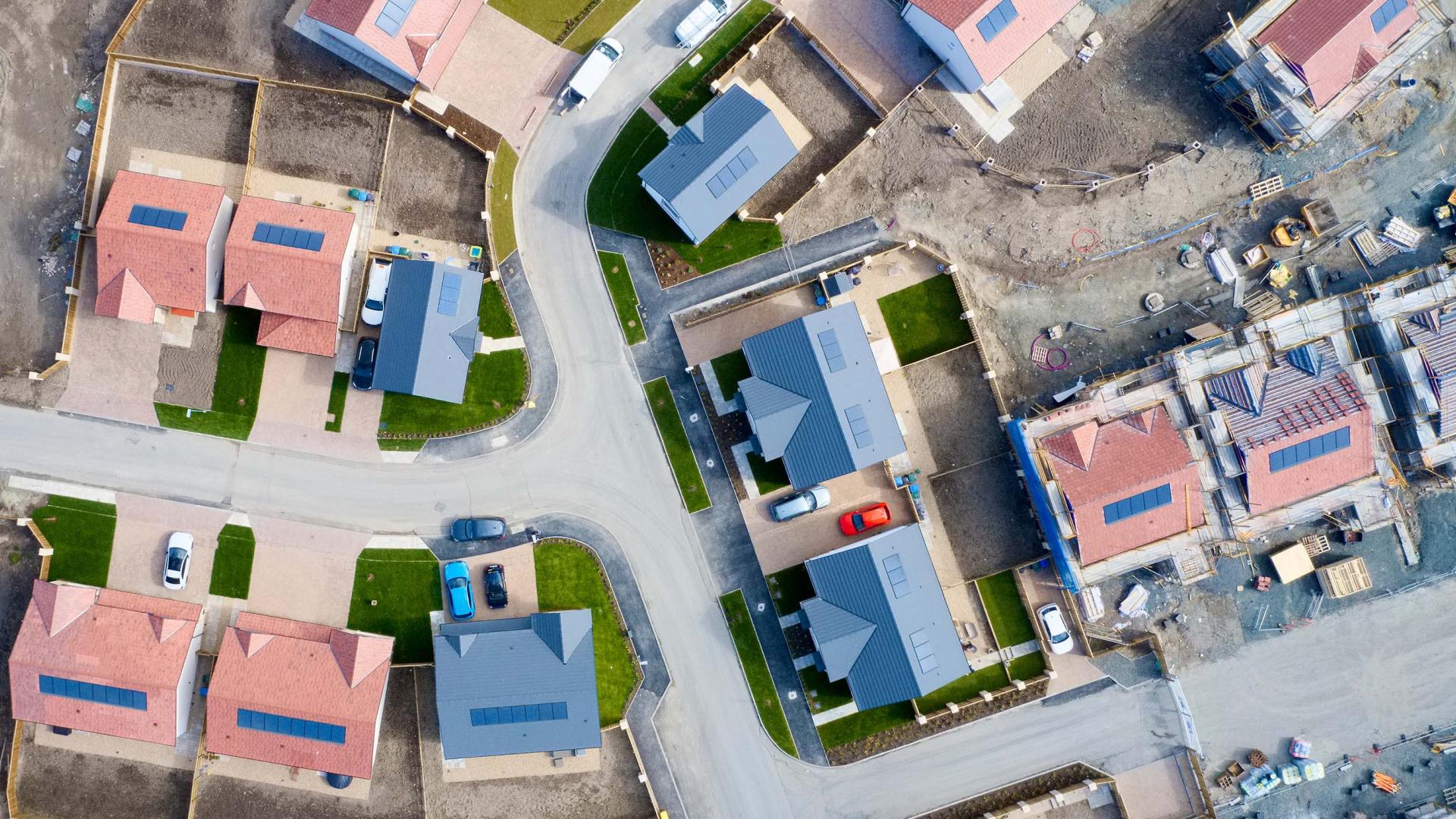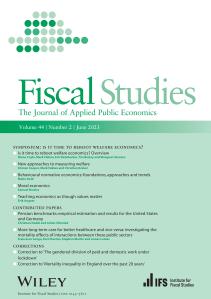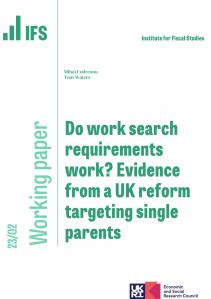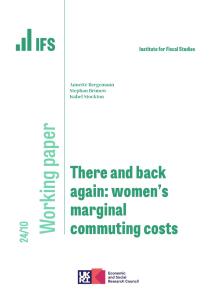This work also draws on work by Henry Overman contributed as part of the The IFS Deaton Review of Inequalities, available to read here.
Levelling Up White Paper: A long term plan for jobs, education and skills essential to success
It is widely expected that Levelling Up Secretary Michael Gove will publish the Government’s ‘Levelling Up White Paper’. This is said to be a “blueprint for spreading opportunity more equally across the country”.
New IFS research shows that regional inequalities have been very persistent. Making a difference will take persistent focus over a long time, with no pretence that genuine or big change can be achieved quickly.
Geographical inequalities in the UK are large and persistent
IFS research - including new research that will soon be published as part of the flagship IFS Deaton Review of Inequalities, funded by the Nuffield Foundation - shows that geographical inequalities in the UK are large and persistent.
There are large wage inequalities across regions.
- In 2019, workers in London were paid £20 per hour on average, 60% more than the £13 in Scarborough and Grimsby.
- Wages at the top are especially unequal. The top 10% of earners in London earned 80% more per hour than the top 10% in Scarborough. About one in seven of the population live in London, but one in three of the top 1% of income taxpayers live there.
- The relative positions of places in terms of their average wages has changed very little over the last 20 years.
Geographical inequalities in labour market outcomes are underpinned by large inequalities in educational attainment, and then by the best educated moving to richer areas.
- Fewer than one in five children from Grimsby go to university and get degrees, compared to one in three children from London.
- Half of the children from Grimsby who get degrees have moved away by age 27, whereas London further attracts graduates through migration.
- As a result, high-skilled people and high-paid jobs are concentrated in London and a handful of other cities.
That said, we shouldn’t forget that poor people live all across the country.
- Wages at the bottom of the distribution are similar everywhere. In 2019, the bottom 10% of earners were paid £8-£9 per hour in all areas.
- The combination of low wages at the bottom and high housing costs means that poverty rates are especially high in London. 28% of Londoners were in relative poverty in 2016-2019, compared to 22% nationwide.
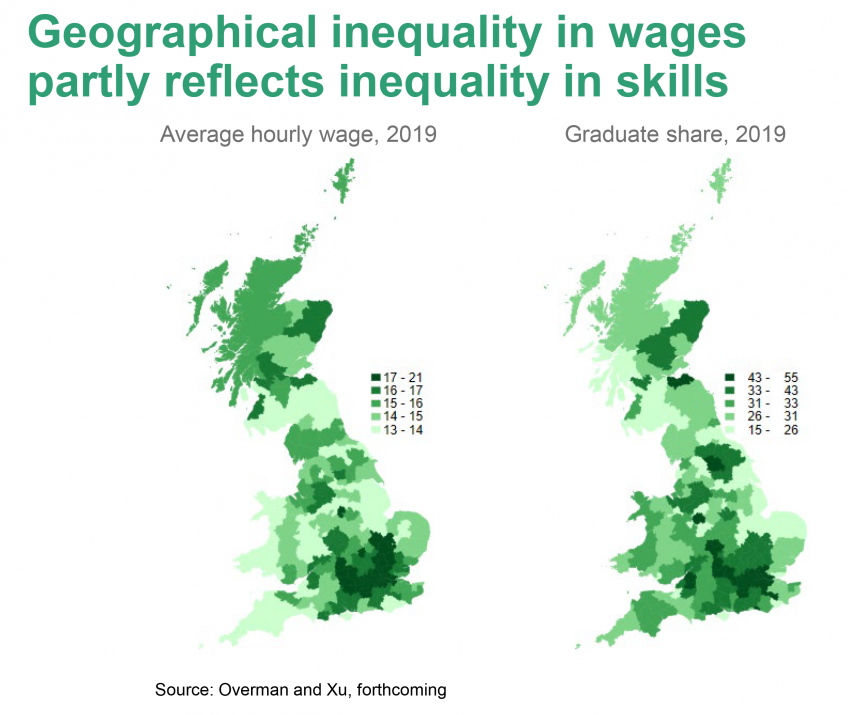
Fiscal redistribution and public spending
Taxes and public spending redistribute significant sums of money from London and the South East of England to the rest of the country, and from richer to poorer areas.
London and the South East pay a higher share of the tax burden
- The amount of redistribution has increased over the last two decades. This reflects a combination of economic trends (such as in property prices) and tax reforms (such as changes in Stamp Duty and income tax) which have increased tax revenues in London and the South East compared to the rest of the country.
- Tax revenues per person in 2019-20 were 88% higher in London than the North East of England, compared to 66% higher in 1999-00.
But a lower fraction of public spending goes to the North than twenty years ago
- For example, whereas public spending in the North East of England was 30% higher than in the East of England in 1999-00, it was just 23% higher in 2019-20.
Over the last decade, cuts to English council and schools’ spending have been larger in more deprived areas.
- Between 2009-10 and 2019-20, spending on non-education services by the tenth of councils serving the most deprived areas fell by an average 31% per resident, almost twice as much (16% per resident) as among the tenth serving the least deprived areas. This was a deliberate policy choice by the coalition government between 2010 and 2015.
- The extent to which schools’ funding is targeted at schools with the most deprived pupils has declined since the early 2010s. Average funding per pupil for the fifth of schools with the highest levels of deprivation fell from 35% higher than the fifth with the lowest levels of deprivation in 2013 to 23% higher in 2019.
These trends matter for aims to level up health and education across the country. There is a growing body of evidence that spending on schools and council services matter for outcomes, especially among the most deprived and those with greater needs.
It is important that funding for public services is based on appropriate and up-to-date estimates of the needs of different places.
- English Council funding is still allocated using data from 2013 and formulas from the mid 2000s, since when there have been massive differences in demographic trends across the country.
- Updated data and a new formula is now used to allocate school funding, but choices the government made when it introduced this formula directly reallocated funding from schools in deprived areas to those in more affluent areas, making levelling-up harder.
A multi-pronged strategy will be needed
The white paper will need to recognise that differences between regions are longstanding and persistent, with differences in wages largely reflecting where high skilled people and good jobs are located.
An effective strategy will have to address the big differences in educational attainment across different parts of the country. But it will also have to consider the extent to which the jobs and amenities that encourage highly skilled people to stay in or move to an area can be spread across all places, or whether certain cities and towns should act as regional ‘hubs’ for high-productivity jobs.
The role of broader tax, public spending and public services policy should not be forgotten. Public services matter for people’s outcomes, and in recent years the way funding has been allocated to different places has often worked against ‘levelling up’.
The ‘levelling up’ agenda is not the first attempt to address the UK’s geographical inequality. Significant progress will require a long-term plan, across multiple policy areas, not least education, skills and economic development.
Making sure tax and spending policy is aligned with the levelling up agenda through, for example, updated funding formulas that target funding at poorer areas, and a revalued and reformed council tax, is a key test of the government’s commitment. It could also be an early ‘win’ in a task that will take many years.
IFS director Paul Johnson said:
“Regional inequalities in incomes, wealth, health and education have persisted for decades. There are far more graduates in places like London and the South East where opportunities for high skilled, well paying jobs are much more plentiful than in other regions. Levelling up economic outcomes between places must mean getting high paid jobs more evenly spread - much easier said than done. Meanwhile, if people born in poorer areas are to see the full benefits of that then educational attainment in these areas must simultaneously be improved, or else many of the good jobs will be filled by graduates moving in. Decisions since 2010 to cut public spending in poorer areas more than in better off ones will not have helped.
It is really important to remember in all this that, while high paid jobs are unevenly spread, low paid jobs, and indeed poverty, are not. A higher fraction of London’s population is in poverty than that in any other region. We need to worry about places, but we need to worry about people too."
Mark Franks, Director of Welfare at the Nuffield Foundation said:
“As this research shows, geographical inequalities in earnings are large, persistent, and determined by the concentration of high-skilled people and high-wage jobs in London and a handful of other cities. Reducing these inequalities between areas requires investment in making moreplaces attractive to high skilled jobs and workers but doing so will not necessarily improve outcomes for lower skilled workers.
“It is important that efforts to reduce geographical disparities are supported by action to address other persistent inequalities in the UK, including in relation to age, gender and ethnicity.
Addressing geographical inequalities is important, but even wealthy areas of the country can still have some of the highest poverty rates. We must not lose sight of the fact that people everywhere should have a fair opportunity for a healthy life and good access to education, public services and employment opportunities.”
